I know how badly you want to remove that irritating greenish buildup on your faucet. The good news is you will understand how to remove it from this article.
We all want our bathroom and kitchen faucets shiny to stay spotless and maintain aesthetics. But when you have hard water flowing through the faucets, it can cause green buildup, amongst other things.
This article will discuss what this Green Build Up means, its causes, its effects, and what you can do to eliminate it. So before replacing that faucet, read this article to find a cheaper solution.
JUMP TO: About Green Buildup | Side Effects of Green Buildup | How to Remove Green Buildup | How to Prevent Green Buildup |
- The green buildup on your faucet is limescale.
- It forms because of the dissolved minerals and hard water.
- Green buildups in faucets are not safe to use.
- You can clear it with vinegar, lime, and baking soda.
- Vinegar remains the most effective way to completely remove it.
What Is The Green Buildup?
If you don’t know what you are dealing with, it becomes harder to take care of it. The green buildup on your faucet is a limescale or copper oxide mixed with more dissolved minerals.
If you’re using copper pipes, the copper material can oxidize with oxygen in the water, giving off a green color. However, the probability of copper oxide being the cause is usually low, as it takes time to rust.
The green buildup in your faucet is usually a result of limescale buildup at the tap. Limescale usually comes in three colors, white, yellow, and green. The natural color of limescale is white, but when it combines with other hard minerals, it gives off a green shade.
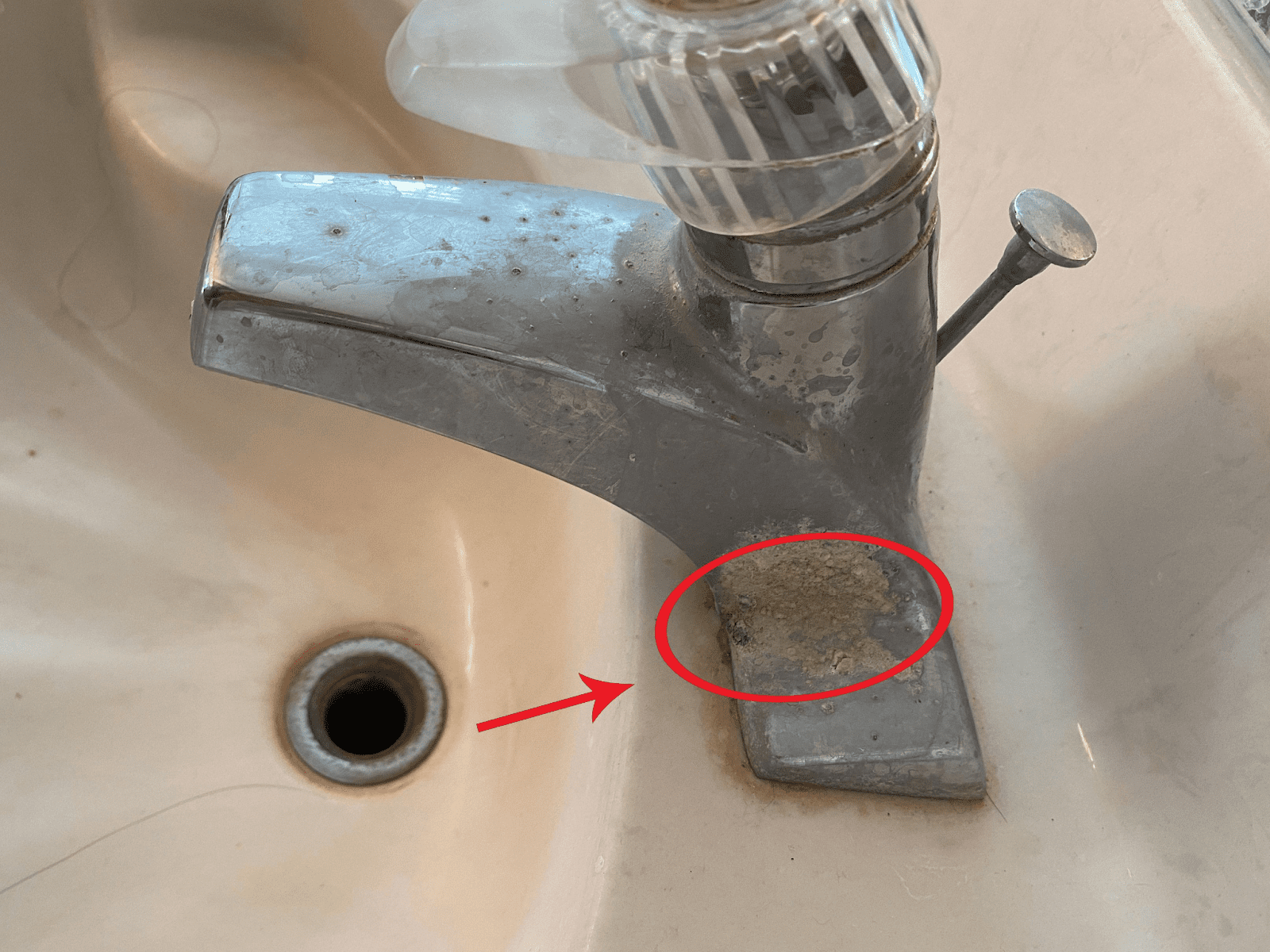
Source: DIY Stack Exchange
What Causes The Green buildup?
These scale deposits build up when the water exhibits hard properties. When it combines with fewer dissolved minerals, it turns into the green stuff.
However, in some cases, the color may not be exactly green.
Also Read: How to Remove Hard Water Stains from Porcelain Sinks?
Here are two possibilities;
- Pure green gunk: If the color is a clear green color, you either have copper oxide or limescale in the faucets, as described above.
- Bluish-green gunk: If the green color is blue, you may have a more complex issue. It indicates that the water’s pH level is low, which means it is acidic.
CAUTION: You should call on professional help if the green deposits have a blue shade. It means the water isn’t safe for your health and your plumbing system.
What Are The Side Effects of the Green Buildup
The first side effect of green buildup in your faucets is the unpleasant look and smell. The green color will disfigure how your kitchen or bathroom looks, irrespective of the design.
However, some of the side effects include the following;
- The limescale buildup can increase, and you will require a lime remover to remove the buildup. These lime removers sometimes have irritating compounds that can affect the respiratory system.
- Usually, the green buildup is due to hard water, which eventually causes limescale deposits that usually spreads across the plumbing system. This will affect the flow of water and reduce the pressure.
- It can damage your plumbing system.
- It can indicate that you’re consuming water containing mild acid and you’re using it for general tasks.
CAUTION: If you use a dishwasher with hard water, you may notice some white or green spots on your plates after use.
How Can You remove the Green buildup on The Faucet?
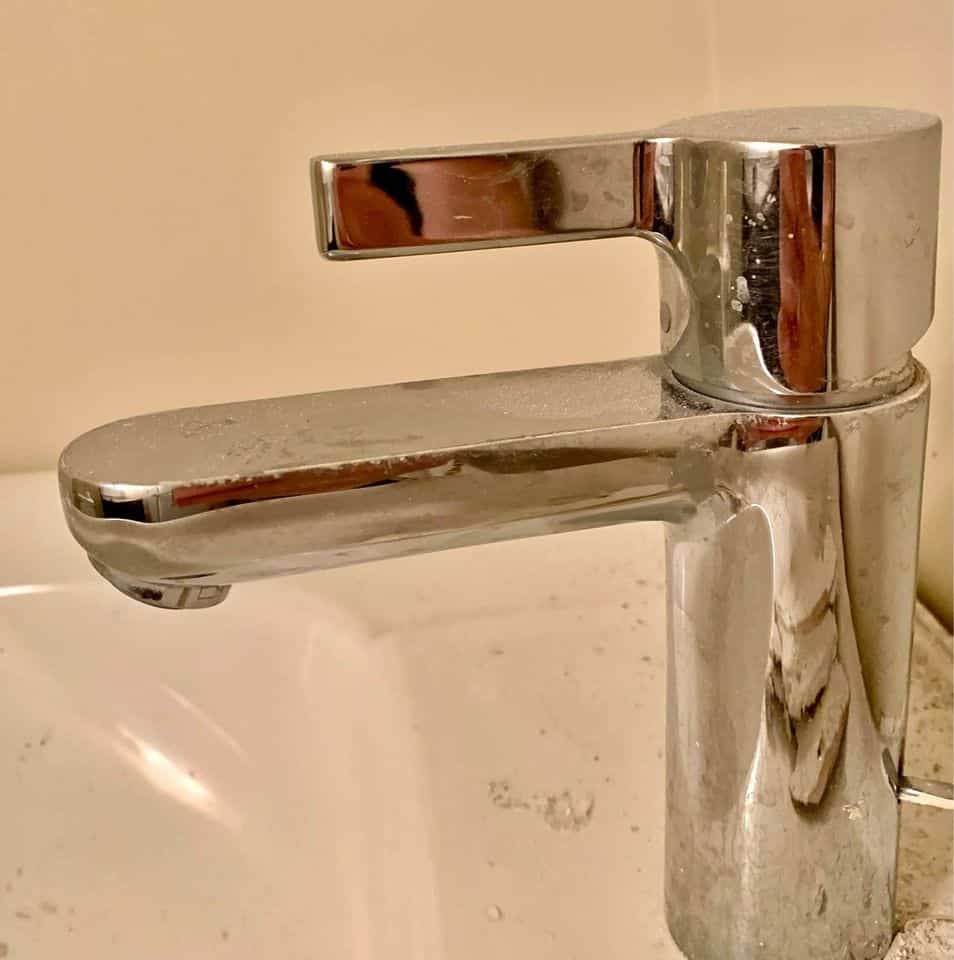
If you notice green stuff on your faucet, your next line of action is to quickly clear it off with a limescale remover. Fortunately, removing the green buildup is relatively easy as long as you have the right tools.
The tools are the regular cleaning rags and agents you’ll usually have in your home. Likewise, the processes are usually the ones you can do independently.
Let’s look at the best ways to take care of the buildup in your faucet.
Did You Know?
According to research, the bacterial presence is very concentrated in the first 100 milliliters of tap flow. It is recommended to leave the tap water flowing after you are back home after being out for a few days.

Source: Xiamen
With Vinegar
Vinegar is one of the most versatile cooking items we have in the home, as it’s useful for baking, cooking, and tough cleaning.
Using white vinegar on the green stuff in your faucet will always work to remove lime scale in its toughest forms. It’s easy to use vinegar with a plastic bag or a paper towel. Here’s the process;
- Pour one-third or half of a cup of vinegar into a strong plastic baggie. If you’re using several paper towels, you must soak them multiple times in a vinegar solution.
- Immerse the affected parts of your faucets in this plastic bag or paper towel. Whether you’re using a plastic bag or several paper towels, you will need rubber bands to hold the vinegar around the faucets firmly.
- If you’re using a plastic baggie, check to confirm that the affected parts are in the vinegar.
- Leave the vinegar solution on the affected solution for hours. It can be two hours for the paper towels and around three hours if you’re using a plastic bag.
- Remove the vinegar solution and wipe it dry thoroughly.
TIPS: Use plastic bags and paper towels soaked in a small bowl simultaneously. The paper towels will be useful to clean the little buildup after the plastic bag has dissolved the thick layer.
Also Read: Why Does My Kitchen Sink Smell?
With Baking Soda
Like vinegar, baking soda is another popular item you’ll find in many kitchens, as many cleaning tips mention. Also, it’s useful to tackle tough stains and is easier to use.
Here’s the process for removing green buildups with baking soda;
- Make a mix of baking soda and water. The amount of baking soda in this mixture should be at least three times the water amount. This will give you a thick mix.
- Use a toothbrush to apply the baking soda solution to the affected areas with buildups. Apply the paste thoroughly.
- Allow the paste to stay in the affected area for about two hours. Wait till the baking soda is dry completely before you gently scrub.
- Rinse the mix away. You may need to use a toothbrush to remove the mix.
- Check for any residues and wash with a clean sponge. Remember to wipe it dry of all baking soda paste.
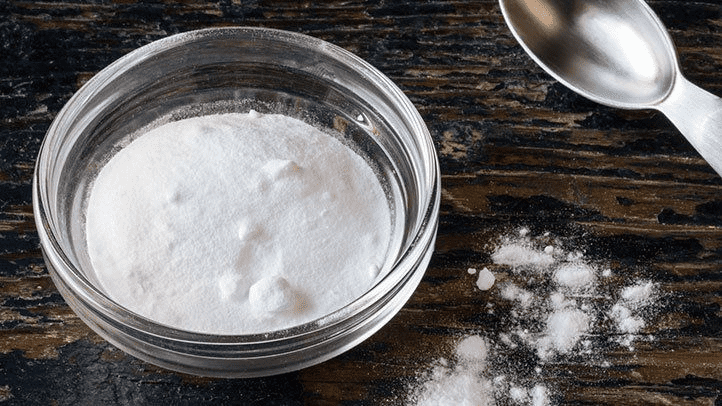
Source: Everyday Health
With Commercial Cleaner
Some commercial cleaners take care of the buildup. The only downside is you need to be sure of the content of the commercial cleaner. Some cleansers contain harmful chemicals that can affect your health, so you must be careful.
A good way to find the perfect commercial cleaner is to buy an ecological one designed to beat limescale.
The process of using the commercial cleaner is easy;
- Try removing as much buildup as possible with an old brush or sponge.
- Make a mix of the commercial cleaner and use it to scrub the faucet.
- Rinse accordingly and re-clean it with a soft cloth.
CAUTION: Commercial cleaners may not completely clear the buildup, so it’s better to use lemon or deep vinegar after.
With Lime or Lemon Juice
Lime or lemon juice is another helpful item in our homes that can tackle hard water, causing limescale deposits. This item usually has citric acid that dissolves green stuff up quickly.
Here’s the process to use lime or lemon to remove green stuff from the faucet;
- First, get raw lime or lemon fruits or purchase pure juice.
- Squeeze the juice onto the affected parts of the faucet. If you’re using the fruit, you can hold it on the affected part. If you have the juice, you can put it in a plastic bag like vinegar and immerse it with a rubber hand.
- Leave the lemon juice on the affected area for many minutes. Around fifteen minutes is enough.
- Use a toothbrush to scrub off the remaining stubborn green stuff. These residues will have lost their strength, so they won’t be too challenging to remove.
TIPS: First, clean the faucet with a normal kitchen cleanser to avoid a constant battle with lemon juice.
How to Prevent Green Residues On Your Faucet
If you’ve had to see and clean the green buildup on your faucet, you wouldn’t want to have the experience again. As much as you can, you’ll want to stop a recurrence.
The best way to stop the green residues from ever coming up is to install a water softener.
A water softener system has resin beads equipped with soft ions. These ions mix and exchange themselves with the ions of the hard water. Hence, you’ll have soft water pass through your systems instead of hard water.
Changing your home pipes is a more effective but overly expensive way of preventing green stuff on your faucet. This step only becomes necessary after an expert has helped you confirm how badly the buildup has affected your pipes.
After the pipe installation, you must prevent hard water from flowing through.
Also Read: Can You Pour Bleach Down The Sink?
Conclusion
The green stuff on your faucet can be very annoying, but with the steps in this guide, you should have a solution.
Each one of the methods described is effective, but you need to have all the tools necessary before you start.
If you’re looking for the quickest solution, cleaning with lemon juice would save you time. However, if the stains have become very stubborn, vinegar is the better option to reset them.
After taking care of the green buildups, remember to use a water softener to prevent a future occurrence.
![16 Types of Kitchen Faucets Explained [With Pros + Cons] 16 Types of Kitchen Faucets Explained [With Pros + Cons]](https://houseadorable.com/wp-content/uploads/2023/02/Roca_griferia_cocina_mencia_negro_DEF_900x505_acf_cropped-1@2x-250x250.jpg)
![Chrome Vs. Stainless Steel Faucets: [An In-Depth Analysis] Chrome Vs. Stainless Steel Faucets: [An In-Depth Analysis]](https://houseadorable.com/wp-content/uploads/2023/03/51gDGcVWBL._AC_UF10001000_QL80_-250x250.jpg)
![Centerset Vs. Widespread Faucets [8 Differences Explained] Centerset Vs. Widespread Faucets [8 Differences Explained]](https://houseadorable.com/wp-content/uploads/2023/03/1_332369605_6500081363358836_8480186754416832788_n-250x250.jpg)
![Pros and Cons of Wall-Mounted Faucets : [Includes Buying Guide] Pros and Cons of Wall-Mounted Faucets : [Includes Buying Guide]](https://houseadorable.com/wp-content/uploads/2023/02/s-l1600-250x250.jpg)
![Kitchen Faucet Vs. Bar Faucet [What is The Difference] Kitchen Faucet Vs. Bar Faucet [What is The Difference]](https://houseadorable.com/wp-content/uploads/2023/01/GettyImages-1177440335-0210e69740fd4045ab6a88f1588e9f4f.jpg)
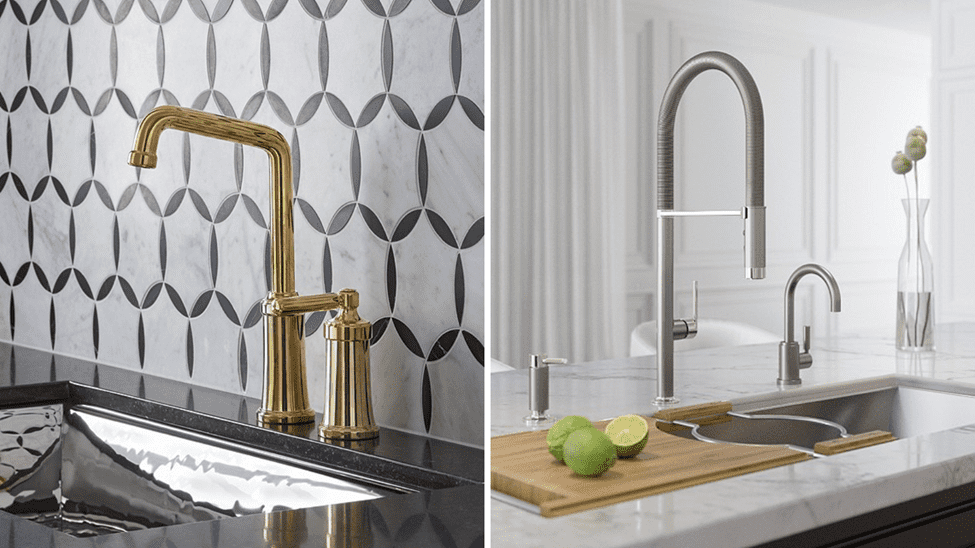
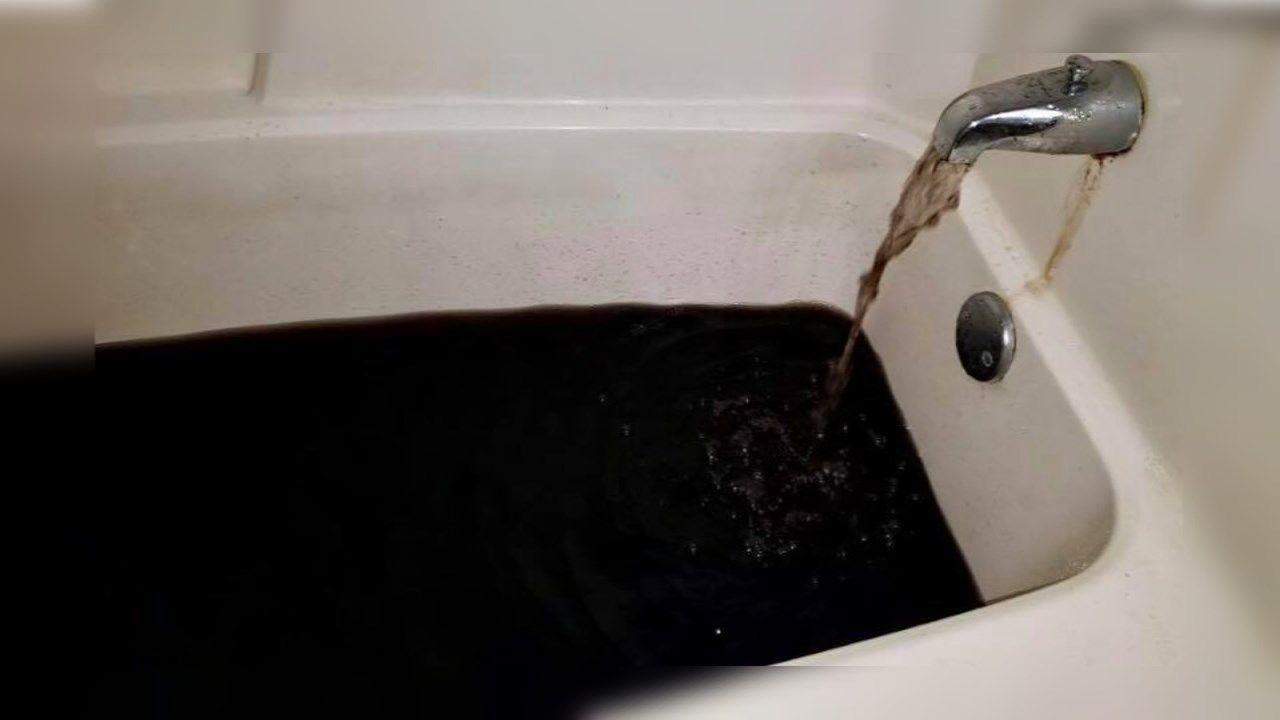
![Pull Down Vs. Pull Out Faucet [9 Major Differences Explained] Pull Down Vs. Pull Out Faucet [9 Major Differences Explained]](https://houseadorable.com/wp-content/uploads/2023/04/image4-3-250x250.jpg)